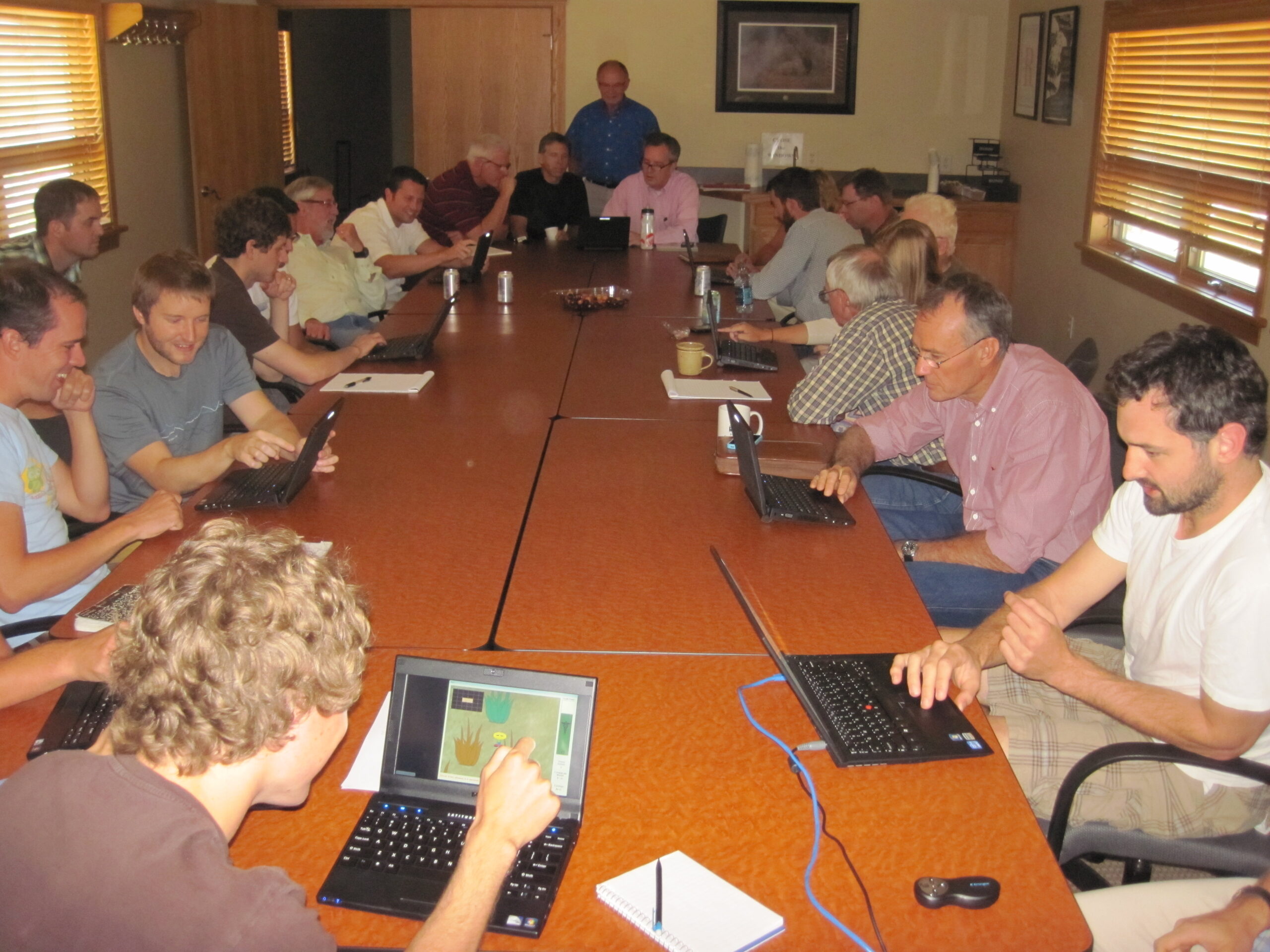
His academic home is in the Economic Science Institute (ESI) at Chapman University as the Donald P. Kennedy Endowed Chair of Economics and Law in Argyros School of Business and Economics and the School of Law. Prior to joining the faculty at Chapman, Wilson was an associate professor of economics at George Mason University.
We thank Professor Wilson for taking the time to answer our questions. For more of PERC’s ongoing Q&A series, see the Q&A series archive.
Q. What is the Economic Science Institute?
The ESI is a group of economists who use the laboratory method of inquiry to explore why exchange systems work the way they do. We investigate how rules and orders form to create wealth, and we build and test new market mechanisms to squeeze out even more. In short, we are interested in understanding why humans are prosperous like no other species on the planet.
Q. Why study the origins of property in the laboratory?
Ordinary people, and especially economists, take the institution of property for granted, but we need look no further than the recent riots in the UK to see just how tenuous that institution is. A popular notion of property is that the government must grant rights to property before it can enforce such rights. But it is from watching our subjects in the laboratory making decisions for cold hard cash that we can come to appreciate that rules of property emerge in precisely the opposite way. To paraphrase in the context of property what Julius Paulus, a third century Roman jurist, said of rules in general, property rights are not derived from rules, but rules of property arise from our knowledge of what is right. In the laboratory we observe from the ground up how people negotiate the rules of property for their virtual community based upon what they consider to be the right thing to do. And more importantly, we learn from the failures, which happen frequently and often spectacularly so, the conditions under which rules of property do not emerge.
Q. In the past you have used a laboratory experiment to explore whalers’ rules of capture in the 17th & 18th centuries. What can we learn from 21st century undergraduates about 400 year old whaling norms?
In my first study on the origins of property in the laboratory, my co-authors and I found that roughly 1.5 out of 6 economies were able to successfully establish a convention of property and experience the gains from specialization and exchange that Adam Smith so famously articulated. It wasn’t from a lack of trying on our part. In three different treatments we gave our subjects tools, both carrots and sticks, which appeared to us to be sufficient to solve the problems that we observed, and not one worked reliably.
From that humbling experience, I thought that perhaps using economic history as guide we might be able to devise a more successful software platform. So we designed an experiment in which our participants could develop, without any suggestion from the instructions or interface, two different historical rules of capture that were recorded as being used for hunting two different types of whales at different times in history. Half of our subjects successfully implemented the earlier historical rule, but not once did the later rule take hold.
When reviewing the data, the first question we asked ourselves was, why did the subjects implement the earlier rule only half of the time? A deeper pass at the data revealed that if there were at least two bad apples (out of six) bent on preying upon their compatriots without remorse, no rule of capture ever emerged. When we subsequently implemented a procedure that weeded out the incorrigibles, every group implemented as predicted the first historical rule of capture, but not the second.
With those same participants we then changed, without announcement or cue, the characteristics of the prey such that the original rule would not efficiently settle the costly question of “Mine or Thine?” while hunting. The tools for the second rule of capture, however, could. In all of the sessions we saw evidence of increasingly costly conflict as soon as the type of whale changed. In other words, we watched the old rule break down. But as an another humble reminder that the conditions for respecting property shouldn’t be taken for granted, we saw little evidence of the second rule emerging to take the place of the first.
Our results indicated that not just any rule of property will do—rules emerge to fit the specific characteristics of the things themselves. Our experiment also showed that the rules of property that do emerge are dependent upon the path of history and, are sensitive to, as the 17th century philosopher Samuel Pufendorf noted, “the tempers of men.”
Q. Some scholars have criticized experimental economics for not giving the subjects time to think or the opportunity to consult with other people about their choices. Yet in most real decisions we get time to ponder and to talk to others. How do you get around this?
In all of my experiments in which participants must build their own institutions and socioeconomic orders from the ground up, a key feature of the software is a public chat room for open-ended communication. While providing such a forum is not sufficient for success, my co-authors and I have found these transcripts to be insightful windows into how our participants view the problems they need to solve. In the whaling experiment, the transcripts are littered with strident moral language following violations of what some perceived to be the right way to behave. Moreover, every group that was successful explicitly discussed the first rule of capture. The absence of discussion is also informative. For example, our subjects did not implement, though it was simple to do so, an equal distribution of prey post hunt, and the transcripts are markedly silent on such a proposition.
Q. Today you ran an experiment on the PERC staff investigating the territorial foundations of human property. Can you briefly describe the experiment?
In this virtual economic terrarium, ten avatars scavenge a plain for berries that grow in shrubs. Half of the avatars are of the large variety and half of the small variety. Each berry that an avatar consumes adds to the avatar’s health and the healthier the avatar, the more money it earns each second. Due to metabolism, the health of an avatar is constantly falling, and if an avatar’s health hits zero, the individual dies and disappears into the luminiferous ether.
The avatars’ habitat supports two types of shrubs, high-producing green shrubs of which there are only a few and low-producing brown ones of which there are many. An avatar all alone in a shrub can pick berries to its hearts content, but if a second conspecific enters the shrub, neither can pick any berries, and a standoff ensues (see picture below).
During a standoff each avatar can take any one of three actions: smile at the other avatar, hit the other avatar, or leave. If an avatar leaves, the remaining avatar can pick the shrub’s berries until another avatar (or the same one) enters the shrub. A hit reduces an avatar’s own health by one point but reduces the other avatar’s health by 3 points, if the aggressor is small, and by 5 points, if the aggressor is large. Smiling is costless.
Non-human animals adjust their fighting behavior to the quantity of resources available and to how the resources are distributed. Non-human animals resolve disputes over resources through conventions of first-come, first-get basis. What do humans do? Does might make right? Does the healthier individual get the resource? Do people, without the aid of language, develop a convention to settle disputes?
We find that if resources are clumpy, as described above, then, yes, people will fight over them, but that if the resources are evenly distributed, i.e., there are no valuable green shrubs, then we observe a dearth of fighting. Moreover, when resources are clumpy a convention arises such that the prior resident won 76-84 percent of the standoffs with a same-sized intruder. When the resources are uniformly distributed, we observed no convention of prior residency. Notice again that the property right of a territory wasn’t derived from a rule imposed from the top down, but based upon the distribution of the resources; a rule arose, without any discussion of what was the right thing to do.
For more on this study, see DeScioli, P & Wilson, B. (2011). The Territorial Foundations of Human Property. Evolution and Human Behavior. Volume 32, Issue 5, Pages 297-304.





